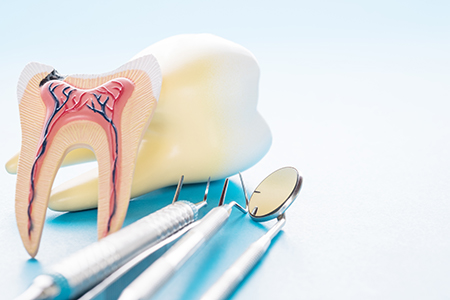If you are told that a tooth requires a root canal procedure, there’s no need for alarm. Today, a root canal procedure is as routine and comfortable as receiving a dental filling. As a matter of fact, a root canal procedure is typically the best way to relieve toothache pain, save a damaged tooth, and preserve your natural smile.
At the office of Bahri Dental Group, we use the latest technology to provide precise and gentle care to help patients maintain healthy, beautiful smiles. Patient care and comfort are our top priorities, and you can rest assured your oral health is in the best of hands.
With a demonstrated success rate of well over 90%, root canal procedures remain the most effective way of saving and retaining a tooth that has been severely compromised by dental decay or injury. Because having a healthy natural dentition supports your oral health and overall well-being, root canal therapy, as opposed to having the involved tooth extracted, is a routine and widely recommended procedure. Across the United States alone, root canal procedures are routinely performed almost 41,000 times daily and close to 15 million times per year.

Your teeth are much more than just the hard outer biting surfaces and the roots. Inside each one is a central chamber containing connective tissue, a nerve supply, and blood vessels. Collectively, these core tissues, known as the dental pulp, help your tooth to grow and mature before it emerges into the mouth. Once your tooth is in place, the dental pulp provides nourishment, keeps the tooth vital, and alerts you of problems.
Having sensitivity to various stimuli like biting down and eating or drinking hot or cold items is a warning from the nerves inside your tooth that dental decay is present, dental trauma has occurred, or infection is brewing. The degree of pain that you experience depends on the extent of the damage and nerve involvement.
When a tooth needs a root canal, it is because the dental pulp has become irreversibly damaged or has died. However, if enough intact tooth structure remains, and there’s good bone support around the compromised tooth, you do not need to have the tooth extracted. A fully developed tooth does not require the dental pulp to remain functional. You can preserve your natural tooth by having your dentist perform a root canal on the tooth.
Although not every instance of dental discomfort indicates the need for root canal therapy, some of the warning signs that you might require this procedure include the following:
Pain is your body’s way of signaling that something is amiss. Although, there are many explanations for oral pain, one of the most common reasons is a toothache caused by decay or damage that has affected the tooth’s inner vital tissues. Patients in need of root canal therapy often report dental pain that wakes them up at night.
If the pleasure of sipping hot beverages or foods are overshadowed by dental pain that makes you wince, it's time to contact our office. Extreme sensitivity to hot or cold foods and drinks can indicate an inflamed, irritated, or non-vital dental pulp.
If it hurts when you bite and chew or when you just touch the tooth, it may indicate pulpal involvement, irreversible damage to the inner vital tissues of the tooth, or the presence of an infection.
A discolored tooth is often a message that the inner vital tissues, including the tooth’s nerve and blood supply, have been compromised. Teeth that have sustained an injury may demonstrate discoloration as the internal tissues have devitalized.
An injury that chips or fractures a tooth can also traumatize the dental pulp or even compromise so much tooth structure that a root canal procedure is required to save the tooth.
Swelling of the gums around a tooth may indicate that an infection has developed. While the swelling can worsen and cause more harmful consequences, sometimes a dental abscess starts to ooze pus and drain. In either case, prompt care is required.
The pathology associated with a tooth need of root canal therapy can damage the bone supporting the tooth and produce some mobility. Root canal therapy can often resolve this issue as tissue healing occurs.

While some of the above signs and symptoms can indicate other dental problems, they all require prompt evaluation and dental care. In some cases, a tooth in need of root canal therapy has not yet demonstrated overt symptoms. It may first get diagnosed and brought to your attention following a comprehensive, routine exam. Typically, these teeth show radiographic evidence of periapical pathology (root end pathology) or other types of structural damage.
It is essential that when a root canal is recommended that you receive timely dental care. Delaying the procedure increases the risk of more widespread and severe symptoms developing. A dental infection can pose significant consequences to your oral health and even threaten your overall health and well-being.
With the modern dental instruments and advanced techniques available today, having a non-surgical root canal procedure is often as comfortable as getting a routine dental filling.
While some root canals can be completed in one visit, others may involve 2 or 3 appointments. How long it takes depends on factors such as the number of canals in a tooth, its anatomy, and whether an active infection is present.
During a root canal procedure, our dentist will remove the diseased dental pulp, clean the internal portion of your tooth, and then fill all the prepared canals with a biocompatible filling material. Root canal therapy is typically performed under local anesthesia, but additional options in dental sedation are available to reduce any anxiety associated with dental procedures.

At the office of Bahri Dental Group, the dental care and comfort of our patients are our top priorities. Our goal is to help our patients enjoy optimal oral health and to keep them well informed every step of the way.
After your root canal procedure, you may experience the following:
Immediately following your dental visit, you may experience a period of lingering numbness. Normal sensation typically returns within an hour or two. However, until the anesthetic has completely worn off, it’s essential to protect yourself from unintentionally biting or injuring your lips, cheeks, gums, or tongue. Be mindful of chewing, drinking hot beverages, or smoking.
A root canal procedure will alleviate the pain of a toothache. However, you may still experience some mild to moderate discomfort in the immediate aftermath when the anesthesia wears off. These feelings should subside within days. To help prevent any undue pressure, which may cause pain, the biting surface of the involved may be slightly filed and taken out of occlusion. Our office will also recommend appropriate over-the-counter pain medications and provide a prescription if indicated.
If you have been given a prescription for antibiotics to treat or prevent an infection, it’s essential to complete the course of medications as prescribed.
Even with a temporary filling, a tooth with a root canal remains vulnerable to stress and can fracture until a permanent crown or suitable permanent restoration is placed. In the interim, be mindful of the involved tooth. Try to chew on the opposite side of the mouth and avoid hard and sticky foods.
While you need to be mindful of a tooth that has received root canal therapy, it’s essential to continue to brush and floss. By maintaining proper oral hygiene, you’re preventing further problems as well as supporting healing and optimal oral health.
To rebuild the strength and integrity of a tooth that has received a root canal therapy, it needs to be restored with a permanent crown or suitable restoration. Until that time, the remaining tooth structure is weak and vulnerable to fracture. The sooner a permanent restoration is placed, the sooner you can bite and chew with confidence and ease.
With proper maintenance and care, a tooth that has been treated with root canal treatment can last a lifetime.
At the office of Bahri Dental Group, we’re dedicated to providing the highest quality of dental care. If you have any additional concerns, continuing discomfort, or signs of an infection, or concerns following your procedure, contact our office for prompt attention and care.
A root canal is a dental procedure that removes diseased or damaged soft tissue from inside a tooth, cleans and shapes the internal canals, and seals them with a biocompatible filling. The internal tissue, called the dental pulp, contains nerves and blood vessels and can become infected because of deep decay, trauma, or repeated dental procedures. When the pulp is irreversibly inflamed or necrotic, root canal therapy preserves the remaining tooth structure and prevents the spread of infection.
Root canal therapy is typically recommended when conservative measures cannot resolve the problem and the tooth can be retained with good long-term prognosis. Preserving a natural tooth helps maintain normal chewing function, supports adjacent teeth, and preserves the jawbone. Modern techniques make the procedure predictable, and success rates are generally high when the tooth is properly restored after treatment.
Common warning signs that may indicate the need for root canal therapy include persistent tooth pain, especially pain that wakes you at night, prolonged sensitivity to hot or cold, swelling or gum tenderness near the affected tooth, and visible darkening of the tooth. Other indicators include pain when biting or chewing and radiographic evidence of infection or periapical pathology detected during a routine exam. However, some teeth that require treatment may be asymptomatic and are identified only through clinical examination and X-rays.
Because symptoms can mimic other dental conditions, a thorough evaluation by a dental professional is essential to determine the correct diagnosis. Your dentist will combine a visual exam, percussion and bite testing, and radiographs to assess the extent of damage or infection. Timely assessment helps prevent progression of disease and allows for more predictable treatment outcomes.
Root canal therapy is usually performed under local anesthesia to ensure patient comfort, and the tooth is isolated with a rubber dam to keep the field clean and dry. The dentist creates a small access opening, removes the infected or inflamed pulp tissue, cleans and shapes the canal system with specialized instruments, and disinfects the canals to reduce bacterial load. Once the canals are prepared, they are sealed with a biocompatible filling material and the access is restored with a temporary or permanent filling.
The length and number of visits depend on the tooth's anatomy and the presence of active infection; some cases are completed in a single appointment while others require two or more visits. Additional measures such as a post or core buildup may be used when substantial tooth structure is missing, and sedation options are available for patients with dental anxiety. After treatment, a definitive restoration is planned to protect the tooth and restore function.
With modern anesthetic techniques and instruments, most patients experience little to no pain during the procedure, and many report that the procedure feels similar to receiving a routine filling. The intense discomfort that often leads patients to seek care is usually caused by the infected or inflamed pulp, and removing that tissue is the step that relieves the underlying cause of the pain. Dentists take steps to control pain throughout treatment, including administering appropriate anesthesia and using gentle techniques.
Some mild to moderate discomfort or soreness is common after the anesthesia wears off and typically resolves within a few days as the tissues heal. Over-the-counter pain relievers are often sufficient to manage post-procedure symptoms, and your dentist will provide instructions to reduce discomfort. Contact the office if you experience increasing pain, persistent swelling, or other signs that suggest complications.
Immediately after the procedure you may have lingering numbness for an hour or two and some sensitivity or soreness in the treated area for several days. Your dentist may recommend over-the-counter pain medication and, if indicated, a short course of antibiotics to address or prevent infection. It is important to avoid chewing on the treated tooth until it has been properly restored to prevent fracture of the weakened tooth structure.
Maintaining good oral hygiene and attending scheduled follow-up appointments supports healing and long-term success. The treated tooth will usually require a permanent restoration, often a crown, to restore full function and protect against future damage. At the office of Bahri Dental Group, patient comfort and clear post-operative instructions are prioritized to help you recover smoothly.
A tooth that has undergone successful root canal therapy and receives an appropriate final restoration can last many years and often for the remainder of a patient's life. The longevity of the treated tooth depends on factors such as the amount of remaining tooth structure, the quality of the restoration, bite forces, and the patient's oral hygiene habits. Teeth that are restored promptly with crowns when indicated have a lower risk of fracture and recurrent problems.
Regular dental checkups and radiographs allow your dentist to monitor the restored tooth and identify issues early. Good home care, including brushing, flossing, and addressing any new symptoms promptly, increases the chances of long-term success. If complications arise, retreatment or endodontic surgery may be options to preserve the tooth.
The primary alternatives to root canal therapy are tooth extraction followed by replacement options such as a dental implant, fixed bridge, or removable partial denture. In very limited cases where the pulp is only partially affected and the tooth is otherwise healthy, procedures such as pulp capping or pulpotomy may be considered to preserve pulp vitality. Choosing between treatment options involves evaluating the overall prognosis of the tooth, the extent of structural damage, and the patient’s oral health goals.
Preserving a natural tooth is generally preferred when possible because it maintains natural chewing dynamics and helps protect adjacent teeth and bone. Your dentist will discuss the benefits and limitations of each option based on clinical findings and diagnostic imaging. A collaborative decision-making process ensures that the chosen approach aligns with the best long-term outcome for your oral health.
Before your appointment, provide an up-to-date medical history and a list of current medications so the dental team can plan care safely and identify any special considerations. If you anticipate anxiety or if sedation has been recommended, arrange for a responsible adult to accompany you and provide transportation as needed. Follow any specific pre-procedure instructions from your dentist, such as fasting guidelines only if sedation will be used.
On the day of treatment, arrive a few minutes early to complete any necessary paperwork and to discuss questions or concerns with the dental team. Your dentist will review the procedure, obtain informed consent, and explain post-treatment care and follow-up arrangements. Being prepared helps the appointment run smoothly and reduces stress on the day of treatment.
A crown is frequently recommended after root canal therapy because treated teeth often have lost significant tooth structure from decay, fracture, or access preparation, making them more prone to fracture under normal chewing forces. A crown covers and protects the remaining tooth, restores functional contours for chewing, and helps distribute bite forces evenly. Without a durable final restoration, a root canal–treated tooth may be vulnerable to chipping or splitting, which can lead to the need for extraction.
The timing and type of restoration depend on the tooth’s location, the amount of remaining structure, and occlusal considerations. Your dentist will evaluate whether a crown, onlay, or conservative restoration is most appropriate and will coordinate the restorative phase to provide predictable strength and esthetics. Prompt restoration after endodontic therapy contributes significantly to the long-term success of the treated tooth.
You should contact the dental office promptly if you experience increasing or severe pain, swelling that worsens, persistent drainage, a fever, or signs of an allergic reaction to prescribed medications. Also reach out if numbness does not resolve as expected, if the temporary filling or restoration becomes dislodged, or if you develop new or worsening symptoms in the treated area. Early communication allows the dental team to evaluate your condition and provide timely interventions to prevent complications.
If you notice prolonged or unusual symptoms after your procedure, schedule a follow-up appointment so the dentist can assess healing with a clinical exam and, if necessary, radiographs. Timely attention to post-operative concerns helps protect the treated tooth and supports optimal outcomes, so do not hesitate to contact Bahri Dental Group if you have questions or unexpected symptoms.
Our goal is to help every patient experience the benefits of good oral health and a beautiful smile. We value the trust you have placed in our office and strive to provide solutions that meet your dental and orthodontic needs and expectations of care.

Phone